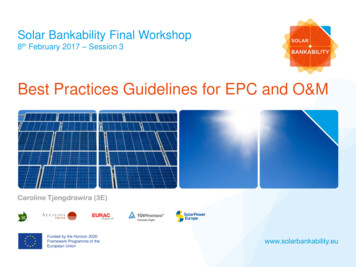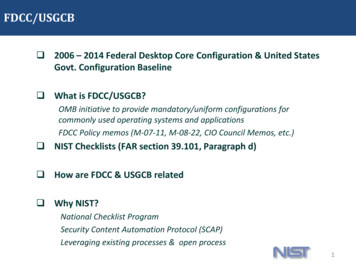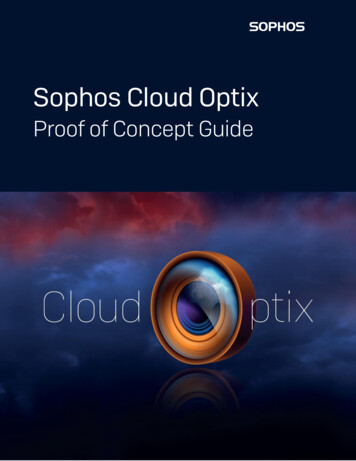
Transcription
OFFICIALASDEFCON (Strategic Materiel)MSR-CHECKLIST-IBR-V5.1MSR CHECKLIST1.IDENTIFICATION: MSR-CHECKLIST-IBR-V5.12.TITLE:3.DESCRIPTION AND INTENDED USE3.1.1The Integrated Baseline Review (IBR) is an integral part of Earned Value Management(EVM), which provides for the review of the Contractor’s execution plans, focusing on theassignment, definition, scheduling and resourcing of work, thus establishing early visibilityinto the acceptability of the Contractor’s planning for the Contract. The IBR also reviewsthe methods and metrics used to measure Contractor performance and progress. Thefocus is upon reviewing the technical merits and resourcing of the plan, and to assess therisk associated with the baseline.3.2The objectives of the IBR are to:INTEGRATED BASELINE REVIEW CHECKLISTa.ensure that the complete Contract scope of work is covered in the Contract WorkBreakdown Structure (CWBS);b.assess whether the technical scope can be accomplished within baseline cost andschedule constraints and that resources have been appropriately distributed to theContract tasks;c.assess that there is a logical sequence of effort that supports the Contract schedule;d.identify areas of risk in resource allocations and in the technical performance of theContract and understand the cost and schedule implications of that risk;e.assess the validity and accuracy of the Contractor’s baseline by examination of atleast one Earned Value Performance Report (EVPR);f.review proposed Earned Value Techniques (EVTs) to be used to measure and reportprogress to ensure that the measures are appropriate and will provide meaningfulindicators of work completed; andg.improve Commonwealth understanding of the Performance Measurement Baseline(PMB), resulting in a better appreciation of the Contractor’s performancemanagement process and the techniques used to measure performance. Thiscommon understanding of the baseline plan should enable improved partneringthroughout the Contract and reduce misunderstandings.3.3This MSR Checklist sets out the Commonwealth’s requirements and minimumexpectations for the conduct of an IBR. The level of consideration needed to address eachof the checklist elements is dependent up on the scale and risks for the Contract. Furtherdetailed guidance on the conduct of an IBR is provided in the Integrated Baseline ReviewHandbook.3.4Capitalised terms used in this MSR Checklist, where these terms are not included in theGlossary to the Contract, have the meaning given in:a.CASG Manual (PM) 006 Defence Supplement to the Australian Standard for EarnedValue Management, AS 4817; andb.AS 4817:2019 Earned value management in project and programme management.4.INTER-RELATIONSHIPS4.1The IBR shall be conducted in accordance with the Approved System Review Plan (SRP),and shall be consistent with the following data items, where these data items are requiredunder the Contract:a.Project Management Plan (PMP); andb.Earned Value Management Plan (EVMP).OFFICIAL1
ASDEFCON (Strategic Materiel)4.2OFFICIALMSR-CHECKLIST-IBR-V5.1The IBR inter-relates with the following data items, where these data items are requiredunder the Contract:a.Contract Work Breakdown Structure (CWBS);b.Contract Master Schedule (CMS);c.Earned Value Performance Report (EVPR);d.System Review Plan (SRP);e.Mission System Technical Documentation Tree (MSTDT);f.Measurement Plan, including the Information Needs and Measures Specification,which the Contract may require to be delivered separately from the MeasurementPlan; andg.Australian Industry Capability (AIC) Plan.Note: The Status column in the following three tables indicates whether or not the associatedChecklist items are able to be tailored by the Contractor in its SRP, based on the followingdefinitions:a.Mandatory items are not to be tailored;b.Highly Desirable items should not be tailored, but may be tailored depending upon thespecifics of the Contract and the Contractor’s internal processes; andc.Optional items may be tailored, based upon the specifics of the Contract and theContractor’s internal processes.Notwithstanding the Status assigned to each Checklist item, the items are to be included in theSRP if they are applicable.5.REVIEW ENTRY CRITERIAItemEntry CriteriaStatusAll data items required to be delivered before IBR have beendelivered (including the IBR agenda, the EVM Systemdocumentation, and at least one complete Earned ValuePerformance Report (EVPR)), and the CommonwealthRepresentative considers these documents to be suitable for thepurposes of conducting IBR.Mandatory2.The CWBS reflects the entire scope of work for the Contract and isdefined to an appropriate level of detail. The delivered CWBScomplies with the requirements of DID-PM-DEF-CWBS.Mandatory3.Subcontractor baselines, where applicable, have been incorporatedinto the PMB, and IBRs on those Subcontractors have beensuccessfully completed by the Contractor.Mandatory4.Risks with the potential to impact upon the viability of the PMB havebeen identified and documented, including any assumptions thatmay need to be referenced in the future.MandatoryAction items from any previous System Reviews or prior riskreduction activities (eg, an Offer Definition and ImprovementActivities phase), which affect IBR, have been successfullyaddressed or action plans agreed with the CommonwealthRepresentative.Mandatory1.5.OFFICIAL2
ASDEFCON (Strategic Materiel)6.OFFICIALMSR-CHECKLIST-IBR-V5.1REVIEW CHECKLISTItemChecklist ItemStatusWere all entry criteria satisfied before starting IBR?MandatoryHas the impact of Approved and pending CCPs been assessed?HighlyDesirableHave all Commonwealth Representative review comments againstdata items been adequately addressed?MandatoryIs all of the work defined in the Contract (including through the Priceand Payments Schedules, SOW, CDRL and the implied workthrough the DIDs) fully incorporated into the CWBS? Do the CWBSand CWBS Dictionary provide a direct cross-reference to theContract?Mandatory5.Is all of the work defined in the Contractor’s management plans (eg,PMP) fully incorporated into the CWBS?Mandatory6.Is all of the work defined in the Subcontracts, including theContractor’s work associated with managing the Subcontracts, fullyincorporated into the CWBS?MandatoryIs the CWBS structured around the major products to be deliveredunder the Contract (eg, Mission Systems) and is the breakdown ofeach Mission System in the CWBS consistent with the productbreakdown structure for that Mission System?Mandatory8.Is the CWBS and associated CWBS Dictionary internally consistent(ie, no overlaps or gaps)?Mandatory9.Does the CWBS Dictionary clearly describe the full scope of workfor each CWBS element?Mandatory10.Does each product in the CWBS have an associated specification,with a plan to develop and baseline the specification at anappropriate time?Mandatory11.Does the hierarchy of specifications and design documents definedin the MSTDT map to the CWBS?MandatoryDo key CWBS elements have defined entry and exit criteria,including, where applicable, acceptance requirements? Are theentry and exit criteria for Milestones and System Reviews, whichare defined in the Contract (including, where applicable, theApproved SRP), traceable to the applicable CWBS elements?MandatoryHas responsibility been assigned for each Control Account andWork Package (eg, through the Organisation Breakdown Structure(OBS) or the Responsibility Assignment Matrix (RAM)) to anappropriate Control Account Manager (CAM) and Work Packagemanager, respectively?MandatoryIs the work assigned to one responsible organisation in a mannerthat represents the way in which work is to be performed?MandatoryIs the RAM consistent with Control Account authorisations?MandatoryDo the CAMs and Work Package managers have an adequateunderstanding of EVM and its implementation for the Contract,including the proposed tools to be used?Mandatory1.2.3.4.7.12.13.14.15.16.OFFICIAL3
ASDEFCON (Strategic st ItemStatusFor each component product within the Mission System productbreakdown structure, does the CWBS facilitate clear and visibleaccountability for ensuring that the delivered component productmeets its specification?MandatoryHas an appropriate division of responsibility been defined; firstly, forthe overall management of Subcontracts and, secondly, for themanagement of those elements of Subcontracts, which eitherinterface with, or are subordinate to, other CWBS elements (eg,lower-level products within the Mission System product breakdownstructure)?Mandatory19.Are the work authorisation documents consistent with the SOW,CWBS and CWBS Dictionary?Mandatory20.Is the organisation assigned in the RAM, also the responsibleorganisation identified in the work authorisation documents?Mandatory21.Are the work authorisation documents approved and signed by theresponsible functional managers designated in the RAM?Mandatory22.Are the Contractor’s risk treatments, which involve work, identifiablein the CWBS?Mandatory23.Is the process for risk management clearly defined andunderstood? Do CAMs understand processes for elevating risks,communicating changes, and statusing their progress?Mandatory24.Is the process for escalating issues within teams and betweenteams defined and understood?MandatoryIs the CMS derived from, and traceable to, the CWBS?MandatoryDoes the draft CMS comply with DID-PM-DEF-CMS?Mandatory27.Does the CMS represent a logical sequence of activities to satisfythe Contract requirements?Mandatory28.Does the CWBS capture a feasible integration and test strategy andis this reflected in the CMS with appropriate linkages andtimescales?Mandatory29.Is the CMS structurally sound (eg, are all tasks suitably linked, havethe appropriate precedence relationships, and minimise the use offorced constraints, such as ‘must start on’)?Mandatory30.Does the CMS comply with any Contract constraints (eg, productioncannot commence until Verification of the first article is complete)?Mandatory31.Does each task in the schedule have a well-defined outcome ordeliverable (with the exception of level-of-effort tasks)?MandatoryDoes the CMS identify all Commonwealth interactions anddependencies that impact upon the Contract timeframes (eg,delivery of Government Furnished Material (GFM) and GovernmentFurnished Services (GFS), attendance at System Reviews andreview of data items)?MandatoryAre the Commonwealth’s interactions and dependencies in theCMS (eg, for GFM and GFS) tied to the Contractor’s CMS activitiesthat reflect the Contractor’s actual need / consumption points?Mandatory17.18.25.26.32.33.OFFICIAL4
ASDEFCON (Strategic st ItemStatus34.Are significant decision points, constraints, and interfaces identifiedas key milestones in the CMS?Mandatory35.Are the Planning Packages readily identifiable? Have the PlanningPackages been defined appropriately, such that they are neither toogeneral nor too large in scope, value, and duration?MandatoryAre the lower-tier schedules vertically traceable to the CMS?MandatoryAre the estimates for task times and resource requirements for bothWork Packages and Planning Packages stable, reasonable andprecedented? Are these task times and resource requirementsbased on sound estimating principles and practices (eg, historical,quantitative, performance estimates)?MandatoryHave the task times and resource requirements for the higher-risktasks (eg, software-development activities) been validated usingmultiple methods (eg, historical data and software-estimatingmodels and tools)?MandatoryIs the basis of estimate for all task times and resource requirementsfor both Work Packages and Planning Packages documented andagreed by those who will be doing the work?MandatoryAre all of the dependencies between Control Accounts clearlydefined in the CMS, and is the meaning / expectations of eachdependency clearly understood by each CAM and reflected in theirrespective plans?Mandatory41.Have all internal and external dependencies been identified andassessed for feasibility? (External dependencies include interfaces,facilities, works and other services, etc.)Mandatory42.Does the CMS include sufficient contingency to absorb “normal”variance (eg, expected levels of rework) as well as some level ofunanticipated events?Mandatory43.Has the CMS been constructed bottom up from quantitativeestimates, not driven by predetermined dates?Mandatory44.Has the CMS been resource levelled to reflect realistic staffavailability, including Contract ramp-up, staff leave/absences, publicholidays, training, Contract ramp-down, etc?MandatoryHave the critical and near-critical path activities been identified?Mandatory46.Have the implications of parallel activities in the schedule beenanalysed to produce a clear understanding of the risks, includingresource overlaps?Mandatory47.Has schedule risk analysis been undertaken to assist in evaluatingwhether the schedule is achievable?Mandatory48.Are the Subcontractor’s schedules vertically and horizontallyintegrated with the CMS?MandatoryDoes the schedule reflect learning curve inefficiencies?MandatoryWhere available, have purchase orders, drawing releases,Subcontract schedules and material ordering schedules beenexamined to confirm consistency between the order and deliverydates and between material milestones and material EVTs?Mandatory36.37.38.39.40.45.49.50.OFFICIAL5
ASDEFCON (Strategic st ItemStatusIs the Contractor’s staff/skills profile reasonable, achievable, andderived from the CMS (particularly for critical skills where there maybe known shortages, such as systems engineers, softwareengineers and integrated logistic support staff)?Mandatory52.Has the dependence on Key Persons been addressed in theschedule?Mandatory53.Are the resources required to meet the schedule available(including personnel, facilities, subcontractor capacity, etc)?Mandatory54.Are Control Accounts adequately described, budgeted anddecomposed to perform the work?Mandatory55.Are the CMS and PMB integrated? Is the scheduling systemintegrated with the budgeting and cost accumulation systems?Mandatory56.Are the schedule(s) and PMB identical in planning and consistent intheir representation of progress?Mandatory57.Are Contractor staff able to substantiate their budgets in terms ofthe total amount (dollars or hours), mix of resources and timephasing?Mandatory58.Is the phasing of the budget consistent with the schedule forachieving the work?Mandatory59.Are the budgets assigned to Planning Packages distributedappropriately to reflect the expected outcome of detailed planning?Mandatory60.Are there adequate procedures for converting a Planning Packageinto a Work Package, including for the establishment of EVTs fornew Work Packages?Mandatory61.Are budgets allocated once and summed appropriately through theEVMS?MandatoryAre all budgeting documents consistent throughout the EVMS? Isthe budget information in the work authorisation documents, theRAM, and the internal performance measurement reportsreconcilable? Are the amounts on internal reports consistent withthe external report being forwarded to the Commonwealth?Mandatory63.Are Control Accounts broken down into different cost elements (eg,labour, materials, and other direct costs)?Mandatory64.Is Management Reserve (MR) clearly identified as such? Is theamount of MR consistent with the Contractor’s assessment of risk?Mandatory65.Are appropriate arrangements in place for the management of MR,including authorising its use?Mandatory66.If MR or Undistributed Budget (UB) has been utilised, do thetransfers reconcile with EVPR amounts?HighlyDesirableFor any aspects of the Contract where there is a high probability ofrework occurring within scope (eg, document revisions andretesting), has appropriate provision for that work been included inthe PMB?MandatoryWhere rework is likely to be required, do the Contractor’sprocedures ensure that zero-budget Work Packages will not beused and that budget will be assigned, the effort planned andperformance measured?Mandatory51.62.67.68.OFFICIAL6
ASDEFCON (Strategic st ItemStatusHave the Work Packages been established so that, if differentelements of cost (eg, labour and materials) have been included in aWork Package, a variance in the performance of one element willnot make an assessment of earned value misleading or inaccurate?Mandatory70.Do the Control Accounts identify EVTs at Work Package level (orlower) to enable effective measurement of progress?Mandatory71.Are the EVTs objective, verifiable, and appropriate for the nature ofthe work being undertaken, including the length of each WorkPackage?Mandatory72.Will progress being reported using the EVT correlate with technicalachievement?MandatoryAre the EVTs consistent with the measures identified in theInformation Needs and Measures Specification (where aMeasurement Plan or a stand-alone Information Needs andMeasures Specification are a requirement of the Contract)?Mandatory74.Where the EVT is identified as ‘percent complete’, does the CAMhave objective measures to identify the progress at a lower level?Mandatory75.Where progress has been claimed, is it in accordance with the EVTidentified?Mandatory76.Are the EVTs to be used for measuring Subcontracted effortappropriate?Mandatory77.Is the Level of Effort (LOE) content of Control Account budgets onlyapplied where appropriate?MandatoryIs the percentage of LOE across the Contract budget less than20%? This percentage should be calculated across Contractorlabour (ie, with materials and other costs (eg, Subcontractors)removed).Mandatory79.Do Control Account status sheets reflect that progress is beingclaimed appropriately?Mandatory80.Are the time-phased budgets (PVs) for the same Work Packagesconsistent with the start and finish dates on the baseline schedule?Mandatory81.Are actual costs are being recorded in the same period as therelated performance?Mandatory82.Are the Control Account or WBS Element start and finish dates onthe Control Account Plans are consistent with the baseline scheduledates?Mandatory83.Is the progress recorded on the schedule reconcilable to the earnedvalue?Mandatory84.Wherever schedules are updated or forecast completion datesamended by CAMs, are these changes reflected in supportingschedules?Mandatory85.Are any discrepancies between schedule progress and earnedvalue able to be explained to ensure that they are consistent?MandatoryAre changes to the schedule(s) appropriately controlled?MandatoryIs the data reliable and producing information useful formanagement decisions? Is earned value being claimed in thesame manner in which it was planned?Mandatory69.73.78.86.87.OFFICIAL7
ASDEFCON (Strategic st ItemStatus88.Is the Estimate At Completion (EAC) being updated and providingmeaningful indication of the likely outcomes?Mandatory89.Is the effect of all known Contractor risks incorporated into theEAC?Mandatory90.Are the cumulative variances either explained and corrective actionplans in place or are the variances reflected in the EAC?HighlyDesirable91.Do the Actual Costs (AC) not exceed the EAC amounts forcompleted Control Accounts or Work Packages?Mandatory92.Does the EAC include Subcontractor updates for actual costs,material values, etc?Mandatory93.Are variance reports being generated that allow for effectivemanagement?MandatoryAre changes incorporated correctly and in a timely manner? Doestraceability exist between the Control Account(s), change requests,MR, UB as appropriate (including current budget to originalbudget)?Mandatory95.Is Subcontractor earned value data being appropriatelyincorporated into the Contractor’s EVMS?Mandatory96.Are appropriate methodologies being employed by the CAMs toverify Subcontractor progress and manage their performance?MandatoryIs material being tracked effectively?MandatoryAre the budgets for material time-phased to support schedulerequirements?MandatoryIs material managed against the original estimated requirement?MandatoryAre the systems for managing material integrated?Mandatory101.Is EAC data updated to account for actual material costs incurredand/ or committed?Mandatory102.Is the process used to track material issued from the Contractor tothe Subcontractor for work appropriate (and vice versa)?Mandatory103.Have overheads / indirect costs been appropriately apportioned tothe Contract?Mandatory104.Does a process exist for monitoring performance againstoverheads?MandatoryIs the company EVMS adequate to meet contractual requirements?Mandatory106.If applicable, is the integrity of the PMB sound enough to supportpayment by earned value?Mandatory107.Are the breakdown and the scheduling of activities in the CWBSand CMS consistent with the AIC Plan, and vice versa?HighlyDesirable94.97.98.99.100.105.OFFICIAL8
ASDEFCON (Strategic Materiel)7.OFFICIALMSR-CHECKLIST-IBR-V5.1REVIEW EXIT CRITERIAItemExit CriteriaStatusAll checklist items have been addressed to the satisfaction of theContractor and the Commonwealth Representative.MandatoryAll major problem and risk areas have been identified and resolvedand, for minor problems and risks, corrective action plans havebeen recorded and agreed by the Commonwealth Representative.MandatoryThe PMB has been Approved.MandatoryPlans for the measurement and analysis program for the nextphase have been agreed by the Commonwealth Representative,including the measures to be collected, associated collectionmethods, and analysis techniques.MandatoryAll risks identified during the course of IBR have been documentedand analysed.MandatoryThe risks with proceeding to the next phase are acceptable to theCommonwealth Representative.MandatoryAll major corrective action requests have been closed.MandatoryAll minor corrective action requests have been documented andassigned with agreed closure dates.MandatoryReview minutes have been prepared, Approved, and distributed inaccordance with the Contract.MandatoryOFFICIAL9
ASDEFCON (Strategic Materiel)OFFICIALMSR-CHECKLIST-SRR-V5.1MSR CHECKLIST1.IDENTIFICATION: MSR-CHECKLIST-SRR-V5.12.TITLE:3.DESCRIPTION AND INTENDED USE3.1The objectives of the System Requirements Review (SRR) are to:SYSTEM REQUIREMENTS REVIEW CHECKLISTa.validate that the system requirements for both the Mission System and the SupportSystem are complete and well formulated, both individually and in sets;b.ensure that the set of system requirements are consistent with the Commonwealth’sintent; andc.ensure that both the Commonwealth and the Contractor have a commonunderstanding of the requirements.3.2This MSR Checklist sets out the Commonwealth’s requirements and minimumexpectations for the conduct of an SRR.4.INTER-RELATIONSHIPS4.1The SRR shall be conducted in accordance with the Approved System Review Plan (SRP),and shall be consistent with the following data items, where these data items are requiredunder the Contract:4.2a.Systems Engineering Management Plan (SEMP);b.Integrated Support Plan (ISP); andc.Verification and Validation Plan (V&VP).Primarily, the SRR addresses the requirements embodied in the:a.System Specification (SS); andb.Support System Specification (SSSPEC),which have been derived from analyses of such documents as the Function andPerformance Specification (FPS), the Operational Concept Document (OCD), and otherregulatory and stakeholder requirements as defined by the SOW.Note: The Status column in the following three tables indicates whether or not the associatedChecklist items are able to be tailored by the Contractor in its SRP, based on the followingdefinitions:a.Mandatory items are not to be tailored;b.Highly Desirable items should not be tailored, but may be tailored depending upon thespecifics of the Contract and the Contractor’s internal processes; andc.Optional items may be tailored, based upon the specifics of the Contract and theContractor’s internal processes.Notwithstanding the Status assigned to each Checklist item, the items are to be included in theSRP if they are applicable.OFFICIAL1
ASDEFCON (Strategic Materiel)5.MSR-CHECKLIST-SRR-V5.1REVIEW ENTRY CRITERIAItemEntry CriteriaStatusAll data items required to be delivered before, and linked to, the SRRhave been delivered and the Commonwealth Representative considersthese data items to be suitable for the purposes of conducting SRR.MandatoryOperational and support concepts and scenarios for the MissionSystem and Support System have been established and are current.Proposed changes to the OCD to address any inconsistenciesbetween the OCD and the SS/SSSPEC have been received by theCommonwealth Representative.MandatoryProposed Deviations to the FPS, to address any conflicts between theproposed SS or SSSPEC requirements and the FPS, have beenadvised to the Commonwealth Representative.MandatoryStakeholder (eg, sponsor, user, operator, maintainer, other systemmanagers) needs, expectations, constraints and interfaces for allphases of each system’s life cycle have been identified, collected,analysed and transformed into system requirements.Mandatory5.WHS, Environmental, legal, and other constraints have been analysedto identify system requirements for both the Mission System and theSupport System.Mandatory6.A preliminary Hazard Analysis, covering both the Mission System andthe Support System, has been completed and reviewed with relevantstakeholders.Mandatory7.Verification and Validation requirements and techniques, for both theMission System and the Support System, have been identified.Mandatory8.Traceability of specification requirements, for both the Mission Systemand the Support System, to their source has been established.Mandatory9.Traceability of Verification methods, for both the Mission System andthe Support System, to their source has been established.Mandatory10.The Contractor has reviewed the Contract plans to assess theirconsistency with the system requirements.HighlyDesirable11.Action items from any previous System Reviews affecting SRR havebeen successfully addressed or action plans agreed with theCommonwealth Representative.MandatoryObjective review criteria have been agreed with the CommonwealthRepresentative for the system-level requirements. Example reviewcriteria include completeness, consistency, singularity, verifiability,traceability and that the level of detail describing the requirements isappropriate and suitable as the basis for Acceptance.MandatoryThe Commonwealth Representative has reviewed the systemrequirements for both the Mission System and the Support System andall comments have been addressed to the satisfaction of theCommonwealth CIALREVIEW CHECKLISTItem1.Checklist ItemWere all entry criteria satisfied before starting SRR?OFFICIALStatusMandatory2
ASDEFCON (Strategic st ItemStatusHas the impact of Approved and pending CCPs been assessed?HighlyDesirable3.Have all Commonwealth Representative review comments againstdata items delivered for the purposes of SRR, been adequatelyaddressed?Mandatory4.Are all sources of requirements valid, appropriate and Approved by theCommonwealth Representative?MandatoryDo the system requirements for both the Mission System and theSupport System accurately reflect the needs, expectations, constraintsand interfaces of stakeholders (eg, sponsor, user, operator,maintainer, and other system managers)?Mandatory6.Have conflicts between the initial Commonwealth requirements andother stakeholder (eg, government regulatory organisations and otherDefence stakeholders) requirements been resolved?Mandatory7.Are the Mission System requirements necessary and sufficient toensure that the system can be used in accordance with the operationalconcepts and scenarios documented in the OCD?MandatoryAre the Support System requirements necessary and sufficient toensure that the Mission System can be supported in accordance withthe operational and support concepts and scenarios documented inthe OCD?Mandatory9.Has an appropriate allocation of functions and requirements betweenthe Mission System and Support System been made (eg, trade-offsassociated with the levels of built-in test / diagnostics)?HighlyDesirable10.Have conflicts between the Mission System and Support Systemrequirements been resolved?HighlyDesirableHave all assumptions made, with respect to defining systemrequirements for both the Mission System and the Support System,been analysed to ensure that they are consistent with the systemsbeing designed and developed?Mandatory12.Are all external interface requirements for the Mission Systemconsistent with the documentation of the external interfaces?Mandatory13.Are all system interface requirements for the new elements of theSupport System consistent with the documentation of the interfaces forthe existing support infrastructure?HighlyDesirableDo the system requirements, for both the Mission System and theSupport System, satisfy the requirements of the Contract and, ifapplicable, the Contract (Support) (eg, applicable standards, practices,SOW, SEMP and ISP)?MandatoryAre the requirement statements well formulated individually and assets?MandatoryIs each system requirement for both the Mission System and theSupport System:a. uniquely identifiable; andb. traceable to its source (eg, FPS, OCD)?MandatoryDo all FPS requirements trace to the Mission System and SupportSystem L3
ASDEFCON (Strategic st ItemStatus18.Do all FPS requirements, which have been modified in tracing to theMission System and Support System requirements, have adequaterationale supporting the changes?Mandatory19.Do all Mission System and Support System requirements that havebeen derived from parent documentation have adequate rati
Glossary to the Contract, have the meaning given in: a. CASG Manual (PM) 006 Defence Supplement to the Australian Standard for Earned Value Management, AS 4817; and b. AS 4817:2019 Earned value management in project and programme management. 4. INTER-RELATIONSHIPS 4.1 .










